Having grown both bush style and pole beans over the past 40+ years in my vegetable gardens. There are certain truths never fail harvest after harvest. One such truth, there is no amount of bribery chocolate, sweet treats, or even offering of money. That will convince my baby girl to eat green beans. However, little Abby, dose like to help building our bamboo trellis in the garden and planting the beans, as long as she doesn’t have to eat a single yukee bean, all is good in her world.
Please allow me invite you. Follow along as we discuss why and how to build a bamboo trellis, and grow pole beans in your raised bed, container garden, and backyard plot. You will be glad you did.

Growing pole beans on a bamboo trellis
by teddletonmr
Want to avoid the backbreaking work of harvesting bush style green beans, sure you do. Grow pole beans on a bamboo trellis, and enjoy the benefits
Bush style snap beans vs Pole Beans
Heavy yields early and done, or consistent yields of tinder snap beans over long harvest season.
First off, we should keep in mind. Bush style green beans grow on compact, self-supporting plants, commonly planted in long rows. That by their very nature has us stooping over, crawling on our hands and knees tending to, weeding, and looking for beans that are ready for picking. Witch by the way produce most beans the firs picking, then fewer each week over a short 3 to 4-week harvest. Making bush snap beans a favorite among those of us gardeners that love to freeze and can their harvest, and do that whole consecutive planting thing.
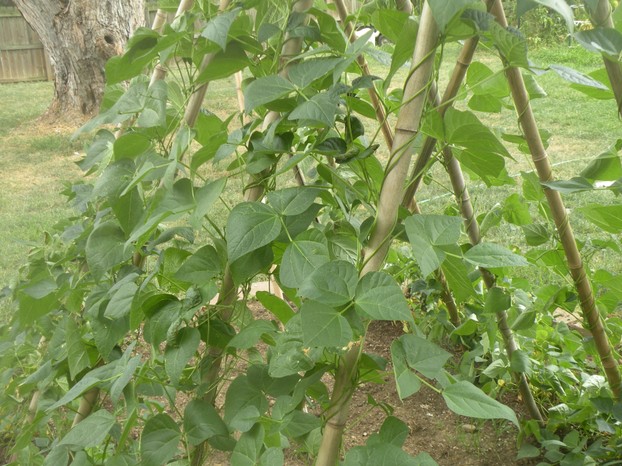 Pole beans growing on bamboo trellis Photo by Teddletonmr |
On the other hand, there is popular string less varieties of easy to care for and harvest pole beans such as 'Kentucky Wonder' and 'Romano Italian. These types of snap beans require a sturdy structure to support the vining string-less bean producing plants.
Resembling a garden hedge, pole beans easily reach heights of 6-feet and more depending on the height of the supporting structure.
Pole beans produce consistent yields over a longer harvest season of eight plus week.
Making enjoying freshly picked beans in salads, stir fry’s, soups and stews through summer and early fall a welcome treat. For gardeners that enjoy investing a little time, effort, and renewable resources to build this bamboo pole bean trellis.
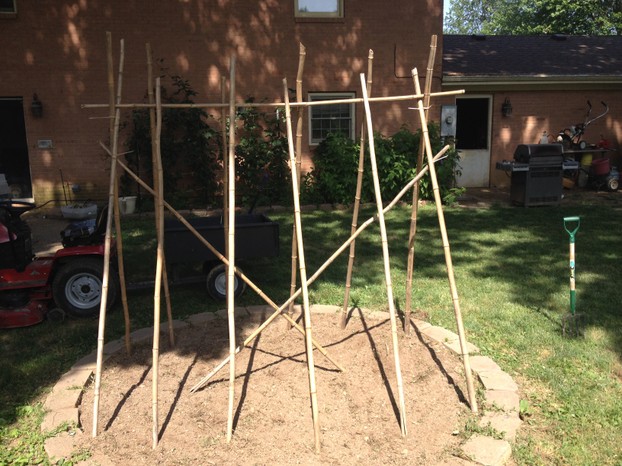 Bamboo pole bean trellis Photo by Teddletonmr |
Stuff needed to build a bamboo trellis
Bamboo poles, cordage for lashing, and a little time
The focus on selecting the materials used to build this sturdy bamboo pole bean trellis, sustainable, biodegradable, and easy on the budget, more to the point cheap. With price and availability the goal here, the amazon links contained in this article. Will help you find stuff you will need to complete this trellis within a reasonable budget, and short amount of time.
 Homemade pole bean trellis Photo by Teddletonmr |
Use Bamboo poles
Bamboo poles are strong, light weight, and last for years.
The numbers of poles needed depend on how big a trellis you need to support your pole bean plants. A simple small tee pee type trellis requires a minimum of three poles equally spaced, at lengths of 5, 6, or 7-feet long. The idea here is to build a trellis that fits you and your garden space. Of which my dear average height wife of 20+ years feels the need to remind me, on those rare occasions I forget myself and build something that accommodates the reach my 6-foot, 6-inch frame is blessed.
Build A-frame style trellis
The A-frame style trellis the kids and I built requires 15, 7-foot long bamboo poles about 1 to 11/4-inch diameter.
For the frugal minded gardeners like me, I found a fellow gardener with a bamboo patch that was happy to give me all the poles I needed for free.
As it happens, bamboo is an invasive plant that grows like crazy and will take over the garden or landscape beds given the opportunity.
Sisal twine / cordage vs nylon wire ties
Sisal twine is made of natural fibers, nylon synthetic.
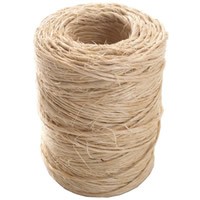 In keeping with the goal of using sustainable materials for building our pole bean trellis, we need select a natural fiver twine / cordage suitable for tying knots and lashings to bind the bamboo poles together securely.
In keeping with the goal of using sustainable materials for building our pole bean trellis, we need select a natural fiver twine / cordage suitable for tying knots and lashings to bind the bamboo poles together securely.
When the time comes to tie a proper knot, not just any slipknot will do the trick. Lashing bamboo poles together requires a special knot that will bind poles securely and not allow the poles to slip out of place.
Thanks to my learning basic knot, and lashing skills as a Boy Scout. Knowing exactly which knot is best for securing the bamboo trellis poles together, rekindles fawn memories of learning how to tie and why use, a diagonal lashing, secured with a clove hitch.
What natural fiber type cordage works great for lashing two or more poles together? Sisal twine is a good choice, it is strong, inexpensive, and unlike synthetic fibers used in nylon wire ties, untreated sisal fibers do break down in the soil.
Knots and lashings
Boy Scout ties timber hitch, diagonal lashing, and clove hitch.
Sisal twine & rope
Sisal twine works great in the garden, sisal rope makes a great cat scratching post :)
 |  |
| Garden Accessory Twine Sisal Biodegra... | 3/8" X 100' Sisal Rope CAT SCRATCHING... |
Tying knots not your thing
Use heavy-duty UV rated nylon cable ties and installation tool
Rather wrapping, frapping, and tying several knots. There is another viable option. Consequently, nylon cable ties are not biodegradable, these types of wire ties otherwise known as zip-ties will do a good job of binding the bamboo poles together.
The thing you should keep in mind, when using cable ties in place of the sisal twine. Remember to follow the same pattern as the wraps of twine use to tie the diagonal lashing. Three wraps of twine, will require three separate wire ties, and so on.
Here is a helpful tip, when using cable ties for assembly a quality cable tie installation gun will make the job easier. This tool makes consistently tightening cable ties less strain on the hands, and cuts the excess wire tie all with the squeeze of a handle, no additional tools required.
Follow the amazon links below for the proper cable ties and installation gun you will find extremely useful and save your valuable time and hard earned money.
Use these cable ties & instalation gun for the best results
 |  |
| Pro Tie B14HD100 14.5-Inch Heavy Duty... | Cable Tie Gun Installation Tool |
 Build a pole bean trellis Photo by Teddletonmr |
Attaching bamboo poles using wire ties
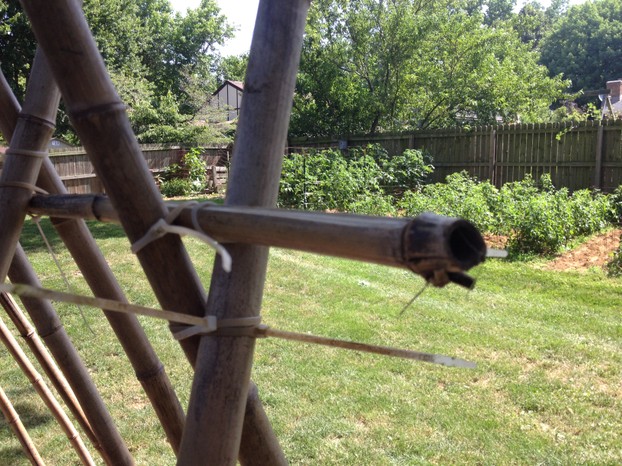 Attaching bamboo poles Photo by Teddletonmr |
Assembling bamboo pole bean trellis
First step in assembling bamboo pole trellis
Start with two bamboo poles of equal lengths; personally, I prefer using something close to eight-foot (2.44m) poles. For the next step, consider enlisting the help of another person, this will make holding and fastening the poles together much easier and less time consuming.
Next step:
Illustrated in the photo, Attaching bamboo poles using wire ties. Take a close look at where the two front vertical poles cross, making an X. The X creates a valley or notch use to support the horizontal pole / ridgepole.
*Something to keep in mind, the goal here, building a custom trellis that fits you and your needs.
Now for the fun stuff:
Before building your custom trellis, get the soil ready for planting. Till or turn soil, test soil ph. levels, add compost, fertilizers, and all the other vegetable gardening tricks you like.
When building this bean trellis there are no absolute dimensions as to how tall or wide the trellis poles are set. Rather worry about measuring this or that. Simply allow your height, reach, and physical abilities set the scale of things.
For instance, as you start building the A-frames that support the trellis, one on each end of the structure.
- Start with one bamboo pole firmly grasped in each hand.
- Standing in the exact location, you want the trellis built. Face in the direction the trellis will run.
- With the bamboo poles, firmly grasped one in your right hand and one in your left hand, extend each arm, with arms bent to elbow length, to your right and left side.
- Now push the end of each pole into the soft soil a couple of inches / 50mm or so. This is easier when you have a helper, one to hold the poles in place, while the other pushes each pole into the well-tilled garden soil. This will help to establish a firm base making the next step easier.
- With the bamboo poles firmly rooted, stand in the center of the two poles, pull them together forming the X at your eye level, and secure the X as illustrated in the photo.
- Next, attach the horizontal ridgepole as pictured to the top of the X created by the crossed poles. This will help establish the location of the supporting poles for the opposite end of the trellis. Build the second A-frame repeating previous steps. When finished, the trellis will look like an A-frame tent without the canvas.
Stabilizing trellis
Center bracing stabilizes bamboo trellis
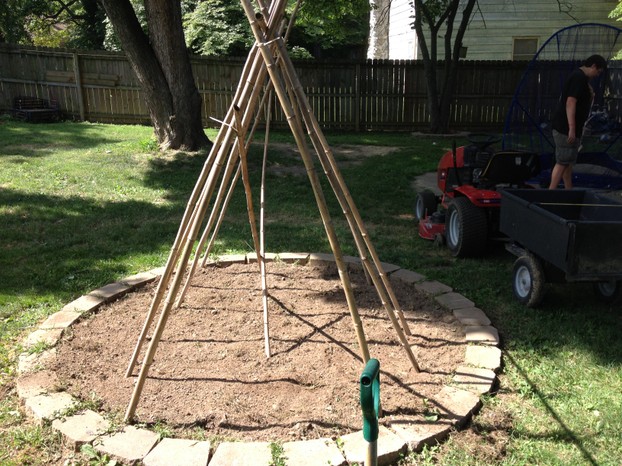 Stabilizing trellis Photo by Teddletonmr |
Finishing touches
With both A-frames build and horizontal ridgepole attached. This is the best time to install center bracing. In the photo above titled Bamboo pole bean trellis. The center braces are clearly visible, running from one leg of both the right and left A-frames to the ground creating an X.
Installing these braces is easy, simply push the end of the bamboo pole into the garden soil at a 45-degree angle a couple inches / 50mm or so and attach to one of the legs of the A-frame. Adjusting the A-frames so they tilt a bit inward / towards the center of the trellis will add stability.
Now it’s time to add the additional poles on each side of the trellis spaced at about 1-foot /30cm intervals.
Simply push each pole into the soil a bit, place the other end atop the horizontal ridgepole, and secure with lashing or nylon wire tie.
All you need do now, plant your pole bean seeds, watch the magic happen, and enjoy the benefits of growing pole beans on a bamboo trellis.
You might also like
The English HedgeEngland is a landscape made by hedges, and now environmentalists are rediscov...
Restoration at Kew Gardens: the temperate houseThe restoration of Kew's temperate glasshouse has been a masterpiece of archi...
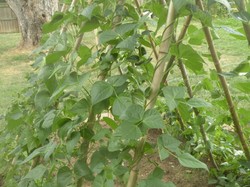




 Apple Watch the Best Talking Watch Bargainon 01/16/2023
Apple Watch the Best Talking Watch Bargainon 01/16/2023
 In-depth review of a Bushcraft Backpacking Survival hatcheton 12/05/2014
In-depth review of a Bushcraft Backpacking Survival hatcheton 12/05/2014
 Winterizing windows – Easy and inexpensive DIY projecton 11/17/2014
Winterizing windows – Easy and inexpensive DIY projecton 11/17/2014
 Growing cucumbers on a trellis is fun and easyon 08/05/2014
Growing cucumbers on a trellis is fun and easyon 08/05/2014

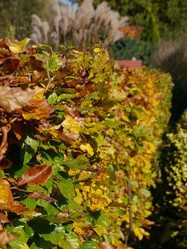
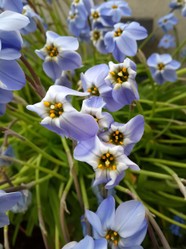
Garden trellis chat
What I did was use one fabric pot with a tomato cage. The beans grew up over the top of the tomato cage, which was next to the deck railing and then used the railing as further support. I also did that this year with my cukes and had those doing the same thing. My little deck comes in handy for supporting my veggies. All I have to do is clean it up a bit once the plants come down.
Dustytoes, thanks for the compliment on the back yard. Assembling a bamboo pole trellis is easier than you might think.
Bamboo not available, use 1-1/4-inch PVC pipe, old broomsticks, wooden closet rods, or narrow boards of yellow pine 1X1-1/4 6-feet long or so will all do a good job for you.
All that said, it sounds as though your tomato cages have worked well for you in the past. I can’t help but wonder do you have several cages in a row along your back deck railing?
Thanks for this tutorial. I grew pole beans last year and used a tomato cage since I had no poles. They also backed up to my deck and used the railing to climb. This year I grew bush beans and that didn't work too well. I will go back to the pole type next year, but I doubt I could assemble your bamboo trellis. Also I am jealous of your backyard!
AbbyFitz, I also like the tender string less blue lake bush beans. The problem for a big guy like me with low vision issues is all the bending over, standing on my head, acrobatics type maneuvers preformed while looking for the tender young beans that are oh so yummy, hidden from my view in all the lush dark bush style green bean foliage.
Conversely, pole beans cling to and grow to the top of a trellis with no need to use the ole panty hose trick, by the way, thanks for the panty hose tip. Beans grown on a trellis are easier for me to see and harvest, before the Kentucky wonders get to big, there by tough and stringy.
The Lazy gardener thing made me smile while thinking , me to.
Be well and take time to enjoy the garden.
teddletonmr
I'm a lazy gardener. I have to admit I use bush beans. Kentucky wonders are great tasting beans though. I remember growing up my dad would plant pole beans. My mother and I were not allowed to throw our old pantyhose away because my dad like to use them to tie up the plants!